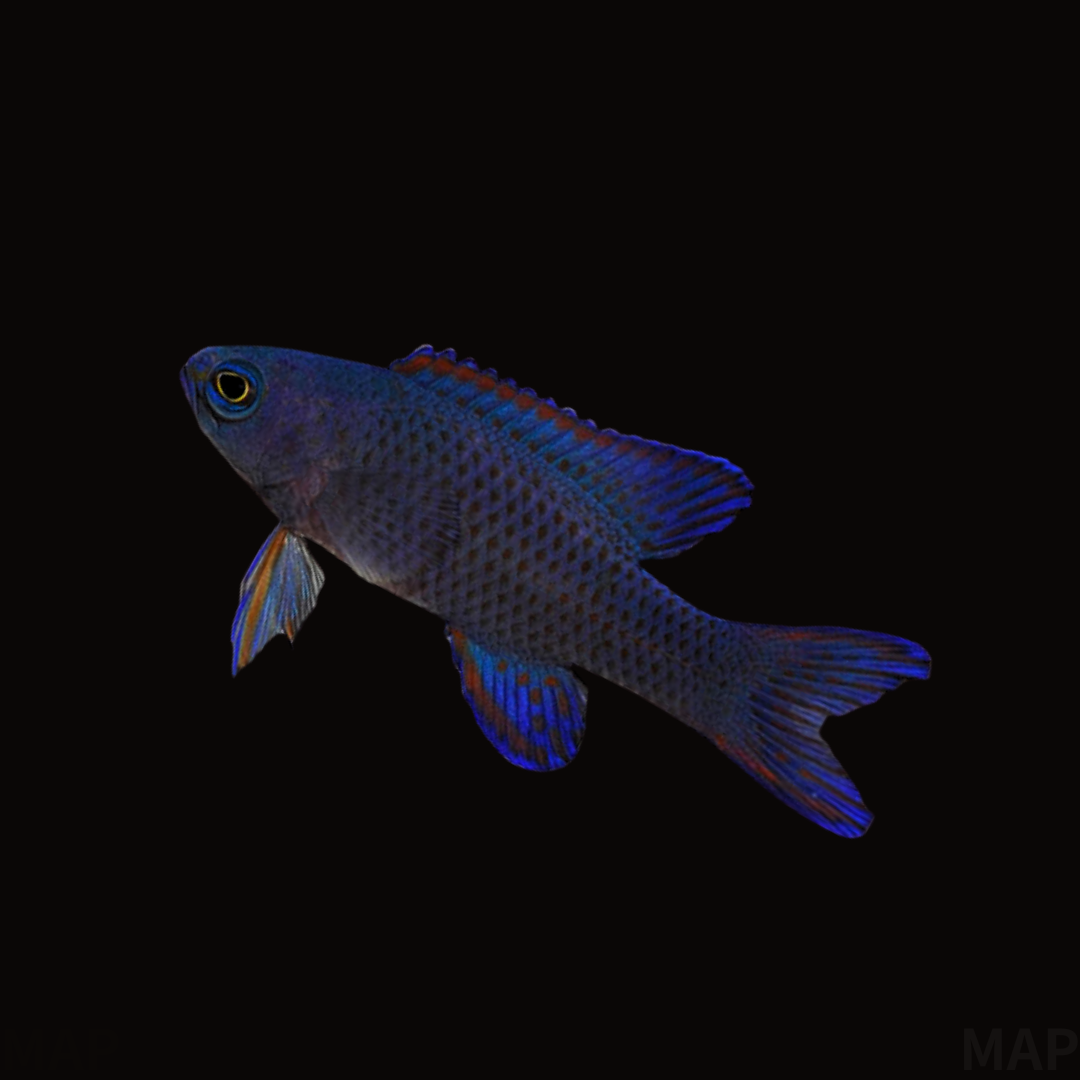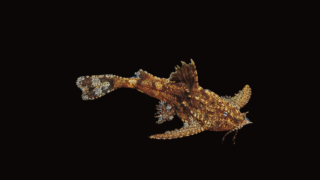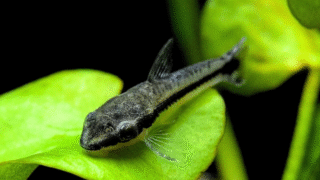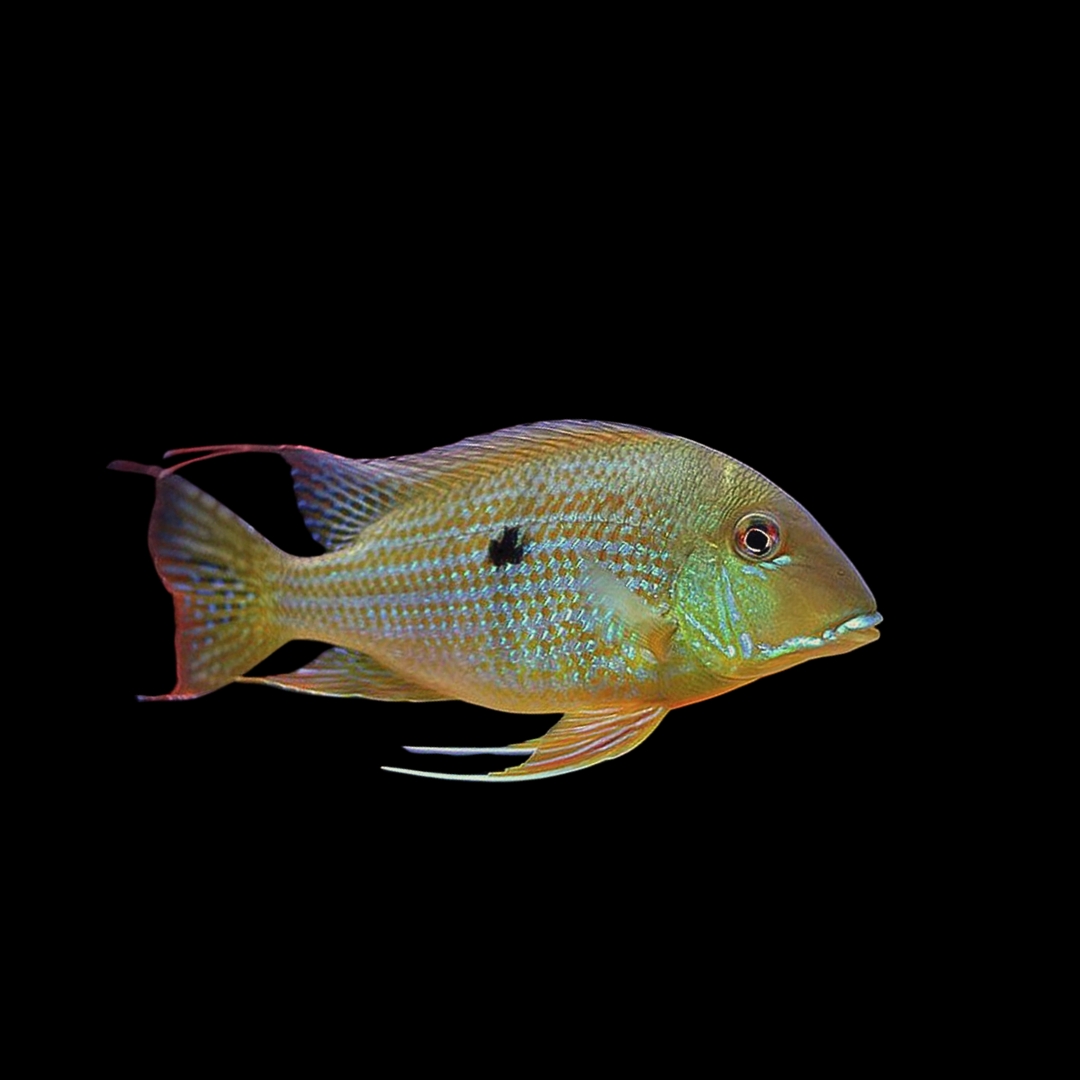解説 / Description
ツバメタナバタウオは、深い藍色から紫色に輝く体色と、洞窟などの天井で逆さまに泳ぐユニークな習性で知られる美しい海水魚です。タナバタウオ科に属し、他の魚に対しては非常に温和なため、サンゴ水槽の住人として人気があります。流通している個体のほとんどが飼育下で繁殖されたものであり、丈夫で人工飼料にも餌付きやすい点も大きな魅力です。ただし、同種に対しては強い縄張り意識を示すため、飼育には注意が必要です。 The Randall’s Assessor (*Assessor randalli*) is a beautiful marine fish known for its deep indigo to purple coloration and its unique habit of swimming upside down in caves. Belonging to the family Plesiopidae, it is very peaceful towards other species, making it a popular choice for reef aquariums. A major appeal is that most individuals available are captive-bred, making them hardy and readily accepting of prepared foods. However, they are territorial towards their own kind, requiring caution in their keeping.
基本情報 / Basic Information
| 学名 / Scientific Name | Assessor randalli (Allen & Kuiter, 1976) |
|---|---|
| 通称 / Common Name | ツバメタナバタウオRandall’s Assessor |
| 分類 / Family | タナバタウオ科 (Plesiopidae)Plesiopidae |
| 英名 / English Name | Randall’s Assessor, Coral Assessor |
| 分布 / Distribution | 西部太平洋(奄美大島以南、台湾など)Western Pacific (Amami Oshima and south, Taiwan, etc.) |
| 最大体長 / Max Size | 約7.5cmApprox. 7.5 cm |
| 寿命 / Lifespan | 5年〜7年5 to 7 years |
飼育環境 / Aquarium Environment
| 水槽サイズ / Tank Size | 単独飼育なら最低110L(60cmワイド水槽や90cm規格水槽が目安)。複数飼育を試みる場合は攻撃性を緩和するため、非常に大きく複雑なレイアウトを持つ水槽が必須です。A minimum of 110L (30 gallons) is required for single-specimen keeping (a 60cm wide or 90cm standard tank is a good reference). To attempt keeping multiples, a very large tank with a complex layout is essential to mitigate aggression. |
|---|---|
| 水温 / Temperature | 22℃〜28℃(24℃〜26℃が理想) |
| 水質 / Water Quality | 比重: 1.020-1.027, pH: 8.1-8.4。安定した清浄な水質を維持することが重要です。Specific Gravity: 1.020-1.027, pH: 8.1-8.4. It is important to maintain stable and pristine water quality. |
| レイアウト / Layout | 飼育成功の鍵はレイアウトにあります。深い洞窟や大きなオーバーハング(岩棚)など、豊富な隠れ家をライブロックで組むことが絶対に必要です。The key to successful keeping lies in the aquascape. It is absolutely necessary to create abundant hiding places, such as deep caves and large overhangs, with live rock. |
| 注意点 / Precautions | 【リーフタンクでの注意】サンゴや他の無脊椎動物に害を与えないため、サンゴ水槽で安全に飼育できます。非常に優れたジャンパーであるため、隙間のない蓋は絶対に必要です。[Reef Tank Caution] It is safe to keep in a reef aquarium as it does not harm corals or other invertebrates. It is an excellent jumper, so a tight-fitting lid is absolutely necessary. |
餌と給餌 / Feeding
| 餌の種類 / Diet | 肉食性。冷凍のイサザアミやブラインシュリンプ、細かく刻んだオキアミや魚の切り身など、多様な動物性の餌が必要です。養殖個体は人工飼料にも容易に餌付きます。Carnivorous. Requires a varied diet of meaty foods such as frozen mysis shrimp, brine shrimp, and finely chopped krill or fish flesh. Captive-bred specimens readily accept artificial foods. |
|---|---|
| 給餌のポイント / Feeding Tips | 1日に最低2〜3回、少量を与えるのが理想的です。臆病な性質のため、導入初期は隠れ家の近くにスポイトなどで餌を運んであげると効果的です。Feeding small amounts at least 2-3 times a day is ideal. Due to its timid nature, target feeding near its preferred hiding spot with a pipette can be effective initially. |
性格と混泳 / Temperament and Tank Mates
| 性格 / Temperament | 他の種類の魚に対しては非常に温和で臆病ですが、同種に対しては強い縄張り意識を持ち、攻撃的になることがあります。Very peaceful and timid towards other species, but can be territorial and aggressive towards its own kind. |
|---|---|
| 混泳の相性 / Compatibility | クマノミ、ベラ、ギンポ、ハゼなど、他の温和な魚との混泳に適しています。大型で攻撃的な魚との混泳は避けるべきです。同種を複数飼育する場合は、非常に大きな水槽と複雑なレイアウトが不可欠です。Suitable for community tanks with other peaceful fish such as clownfish, wrasses, blennies, and gobies. Avoid housing with large, aggressive fish. Keeping multiples requires a very large tank with a complex layout. |
病気と対策 / Diseases and Prevention
| かかりやすい病気 / Common Diseases | 比較的丈夫な魚ですが、ストレス下では白点病などの一般的な病気に罹患する可能性があります。臆病な性質のため、病気の早期発見が難しい場合があります。A relatively hardy fish, but can be susceptible to common diseases like Marine Ich (*Cryptocaryon*) under stress. Its shy nature can make early disease detection difficult. |
|---|---|
| 対策と予防 / Prevention | 豊富な隠れ家を提供してストレスを最小限に抑え、安定した水質を維持することが最良の予防策です。新規導入個体は徹底した検疫を行うことが重要です。Minimizing stress by providing ample hiding places and maintaining stable water quality is the best prevention. Thorough quarantine of new individuals is crucial. |
増やし方(繁殖) / Breeding
| 繁殖形態 / Reproduction | オスが巣を作り、産み付けられた卵を保護する「ネストビルダー」です。一般的に知られている「マウスブルーダー(口内保育)」ではないことが、養殖業者によって確認されています。It is a “nest builder,” where the male creates a nest and guards the laid eggs. It has been confirmed by commercial breeders that it is not a “mouthbrooder” as commonly believed. |
|---|---|
| 繁殖のポイント / Breeding Tips | 現在市場に流通している個体のほぼ全てが、米国の養殖業者(ORA社)によって繁殖されたものです。これにより、野生個体群に負荷をかけることなく、丈夫な個体が入手可能になっています。個人での繁殖は、ペアリングの難しさから非常に困難です。Almost all individuals in the market are captive-bred by the U.S. breeder ORA. This makes hardy individuals available without putting pressure on wild populations. Breeding by individuals is very difficult due to the challenges of pairing. |
特徴的な行動と豆知識 / Behavior and Fun Facts
| 特徴 / Characteristics |
【逆さまスイマー】本種は、洞窟や岩棚の天井に沿って逆さまの状態で定位し、泳ぐ習性があります。これは病気ではなく、彼らの正常で自然な行動です。 【繁殖の定説を覆す】長年、近縁種からの類推でオスが口内で卵を育てる「マウスブルーダー」と考えられてきましたが、養殖の成功により、実際には巣で卵を守る「ネストビルダー」であることが判明しました。 【サステナブルな選択】本種は米国の養殖業者によって商業的な繁殖が確立されています。日本市場ではフィリピンなどからの天然採集個体が主流ですが、丈夫で環境に慣れた養殖個体が入手できる場合は、野生資源に負荷をかけない持続可能な選択と言えます。 【Upside-Down Swimmer】This species has a habit of orienting and swimming upside down along the ceilings of caves and overhangs. This is normal, natural behavior, not a sign of illness. 【Overturning Breeding Theory】For many years, it was thought to be a mouthbrooder based on related species, but successful aquaculture has revealed it is actually a nest builder that guards its eggs. 【A Sustainable Choice】Commercial breeding for this species has been established by a US breeder. While wild-caught individuals from places like the Philippines are mainstream in the Japanese market, choosing captive-bred individuals when available is a sustainable choice that doesn’t pressure wild resources. |
|---|
まとめ / Conclusion
ツバメタナバタウオは、そのユニークな行動と深い藍色の体色で、飼育者を魅了する魚です。他の魚には温和で、サンゴ水槽にも安全、さらに流通個体が丈夫な養殖個体であるなど、多くの長所を持っています。飼育の成功は、臆病な性質を理解し、豊富な隠れ家を提供できるかにかかっています。 The Randall’s Assessor captivates aquarists with its unique behavior and deep indigo coloration. It has many advantages, being peaceful with other fish, reef-safe, and available as hardy captive-bred individuals. Success in keeping it depends on understanding its timid nature and providing abundant hiding places.
同種間の争いは激しいため、原則として単独飼育が推奨されます。これらの点を理解すれば、経験豊富なアクアリストにとって、長期にわたり楽しめる素晴らしいパートナーとなるでしょう。As fights among its own kind are intense, single-specimen keeping is recommended in principle. Understanding these points will make it a wonderful and long-lasting partner for the experienced aquarist.
▶ 記事の生体をAMAZONで買う ▶ 記事の生体をYahooで買う












コメント